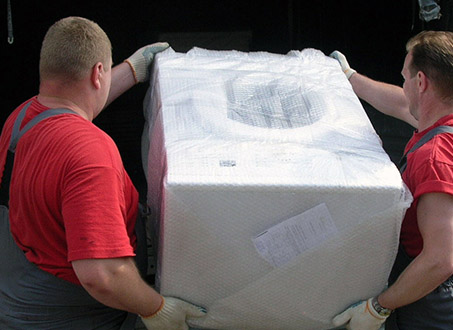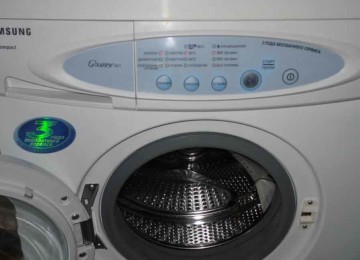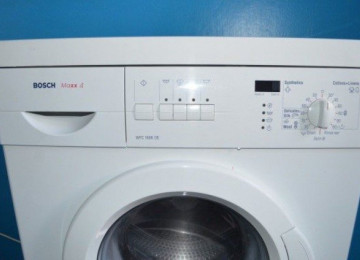When transporting a new or used washing machine, many make the same mistakes - they incorrectly pack, load and transport the equipment. As a result of such manipulations, a variety of breakdowns occur, so it is important to find out in advance how to transport a washing machine.
Preparing the washing machine for transportation
Before placing the washing machine in the washing mashine, you need to pack it properly. The ideal option is to use a factory box specifically designed for this purpose. But since the “original” packaging, as a rule, is not preserved for a long time, you should pack the machine using improvised means.
The preparation of the machine is carried out in several stages:
- Disconnecting the unit from the power supply, water supply and sewerage.
- Draining the liquid remaining after washing. It is very important to remove all the water and wait a while for everything inside to dry. This is necessary to prevent moisture from getting on the electronics of the unit.
- Securing wires and hoses for ease and safety of movement.
- Sealing corners and traumatic elements with tape.
- Secure the drum with transport bolts. If they are lost over time, you will have to secure the drum in another way - remove the back cover and place some materials, such as foam rubber or rags, in the opening between the wall and the tank, then attach the panel back. This will mitigate vibrations during transportation.
- Housing protection is another important consideration. If there is no original packaging, it is enough to wrap the machine in cloth, cardboard, polyethylene or something else, tying it with a rope on top.
When these manipulations are completed, you can begin transportation, but even here there are rules that cannot be avoided.
What are shipping bolts used for?
Fasteners that protect the internal parts of the machine from damage are called transport bolts. They are a mandatory element that comes with new equipment, but over time they can be lost, and if there is a need to transport the unit, it is important to find a replacement for these fasteners.
The tank and drum are secured with shock absorbers and springs, which minimize vibrations that occur during operation of the machine. But when transporting equipment, shocks and shaking cannot be ruled out, which can lead to damage to the drum, breakage of fasteners and other troubles. Shipping bolts secure the drum firmly in the housing, preventing possible damage when moving the washing machine.
Transportation of washing equipment
The next step after preparing and packing the machine is loading and transportation. Here you need to understand that this type of equipment can only be moved vertically or on the back cover.It is extremely undesirable to tilt it, much less turn it over. Transportation on the front wall is almost guaranteed to lead to failure of the equipment. Only a slight tilt is acceptable if it is inconvenient to carry the machine vertically.
It is possible to carry and transport the machine on its side, but only in exceptional cases and very carefully, trying to avoid sudden stops and hesitations. Professionals advise moving the machine vertically or on the back wall with the tank attached.
It is recommended to turn the unit itself sideways in the direction of travel. For reliability, you can ensure that the unit remains stationary with other objects in order to minimize the risk of breakdowns.
It is not recommended to turn the machine over for one simple reason - the moisture remaining inside will drain onto the control panel, which is absolutely not allowed, as this will entail expensive repairs. Before placing the washer on the back wall, you should make sure that there is no liquid in the powder container to prevent the board from getting wet.
Almost all washing mashines can be moved on the back cover. An exception is Zanussi washing machines: the equipment of this brand has such an arrangement of heavy counterweights that they can severely damage the fill valve.
Rules for carrying and loading the washing machine into a washing mashine
Carrying and loading the machine requires compliance with the following rules:
- Carry only vertically. A small angle of inclination to the rear wall is acceptable.
- It is better to carry the equipment with two or three people, as it is quite heavy.
- For transportation, it is better to choose a truck rather than a washing mashine.
- You can place the machine in the washing mashine standing or on the back wall.
- The washing machine should be additionally secured with other objects to prevent possible falls or vibrations.
Moving and loading the washing machine requires special care. It is extremely undesirable to make mistakes at this stage, as this will certainly affect the serviceability of the equipment.
Transportation methods
Transportation is the most critical stage, which should be given maximum attention. There are several acceptable ways to move the machine:
- Vertical (standing) is the main and most correct method of transportation.
- On the back wall (except for Zanussi machines) - this method is acceptable if the washing machine is transported in a passenger washing mashine, or for other reasons it is not possible to place it vertically.
- It is extremely undesirable to transport the machine on its side, as this method is accompanied by a high risk of malfunctions.
In all cases, it is advisable to place the machine sideways in the direction of movement, and also press it well with other things.
Throughout the entire journey, the driver must monitor his speed and try not to hit potholes in order to ensure maximum immobility for the delicate load. This will allow you to deliver the washing machine to the desired location while maintaining its full functionality.
How to transport without shipping bolts
Frequently, shipping bolts are lost and the washing machine needs to be transported. For everything to go well, use improvised materials instead of factory fasteners. This requirement cannot be neglected, since the risk of machine breakdown when moving without securing the tank will be very high.
So, you can line the tank on all sides with soft materials in such a way as to completely immobilize it. Foam rubber or rags are excellent for these purposes. The tank must first be emptied by unscrewing the screws at the back and removing the top cover of the unit. Then you can begin fixing the tank.
Transporting a new washing machine
Delivery of a new washing machine usually does not cause any inconvenience to the buyer, since transportation is usually handled by store employees or shipping services. New equipment is transported in packaging with the necessary reinforcing materials, which helps maintain the integrity of the contents.
The buyer will also not need to think about transportation bolts - they are provided by default in every new washing machine. But after the equipment is delivered to the required place in the apartment, you must remember to remove them before the first operating cycle of the machine. You shouldn’t throw them away; it’s better to save the bolts so that you can move and transport them without any problems in the future.
What happens if you don’t follow the rules for preparing equipment and transporting it?
Washing machine owners do not always delve into the details of proper loading and transportation of equipment, resulting in a variety of malfunctions. Even a short trip (15-20 minutes) can lead to complete breakdown of the unit. You may encounter the following problems:
- Broken power cord.
- Damage to the hatch cuff.
- Damage to shock absorbers.
- Drain pump offset.
- Short circuit and oxidation of contacts due to remaining moisture.
- Drain pump failure.
- Control panel failure.
- Damage to the hull.
- Damage to the detergent drawer.
Sometimes one small mistake is enough to say goodbye to your beloved assistant forever or to pay a lot of money for its repair. Transporting the washing machine requires care and compliance with the necessary rules. The unit must be carefully monitored at every stage - from packaging to installation in a new location. Only this approach can reduce the risk of malfunctions to zero. Otherwise, the owner will have to pay for repairs, since such breakdowns are not repaired under warranty.
A washing machine is a very delicate item that should be handled with care both during operation and during packaging, loading and transportation. Before this kind of manipulation, you should learn about the basic rules in advance, and also make sure that your assistants also know about them. If you have the slightest doubt about your own abilities, it is better to entrust this difficult task to professionals - for little money the unit will be delivered to the specified location safe and sound.









